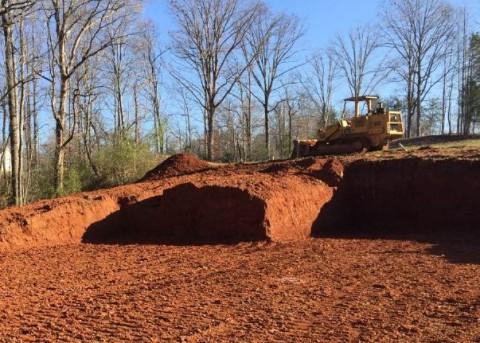- Our Building Philosophy
- Our Process
- Home Plans
- Our Work
- Reviews & Awards
May 17, 2016
Understanding the site prep phase of construction gives you a more complete picture of the many steps required when building a new home.
Does it seem like everyone, everywhere, is building a new home?
A construction boom is indeed under way here in Upstate South Carolina, so it’s a common occurrence to drive past previously undeveloped property and see fleets of earth-moving equipment, multiple colored stakes in the ground, and the beginnings of streets, sidewalks and foundations. These are the tell-tale signs of site prep as builders ready the land for construction.
Site preparation includes several steps. A survey comes first. Topographical features — trees, streams, rocky outcroppings, relative elevations and open areas — are carefully marked, providing the basis for everything that follows. Property lines must be located precisely to confirm setbacks (the allowable distance between a structure and a property line) in compliance with local codes.
Streets and sidewalks are mapped and flagged. Then the surveyors stake out the location of the various underground utility conduits through the neighborhood and to each future house. In the case of a single house under construction, the existing utility services in the neighborhood must be located and the connections to the proposed house carefully plotted. Finally, a soil test is ordered to help determine the type and design of the foundation construction.
Most, if not all, of this information is mandated by the local building authority. Copies of the surveys and tests, usually signed and stamped by a registered professional engineer, must be attached to the proposed construction drawings and submitted for permits or approvals from that authority.
Once those steps are taken and the plans are approved by the building department, the next “site prep” step can be taken. The location of the foundation or footprint of the home is staked to provide a guide for excavation. Typically, the stakes and batter boards (which demarcate every corner or turn in the layout) are connected by nylon strings to outline the exact perimeter of the foundation to be built.
Then backhoes or excavators can get to work, digging ditches to extend existing or new utility conduits — for electrical, plumbing, natural gas, etc. — to serve the house. Foundations are excavated using the staked-out lines as a guide. The plans will call for footings and — according to individual designs — a crawl space, full basement, concrete slab, or perimeter foundation walls in preparation for concrete forms, blocks, or other materials to support the main floor.
Every new home — whether part of a new home community or an on-your-lot project — requires these site prep steps. Understanding this phase of construction enables clients to track progress and get a complete picture of what is required when building a new home.
Latest Blog Posts
DOE’S HOUSING INNOVATION AWARDS PROGRAM RECOGNIZES NATION’S TOP BUILDERS ON THE PATH TO ZERO ENERGY READY HOMESTwo Addison Homes projects have earned 2016 Housing Innovation Awards from the U.S.... Read more
Addison Homes won the Southern Home & Garden Bridge Award for Green Building for the third consecutive year.This award-winning green home enjoys a savvy-yet-simple aesthetic – neutral palette,... Read more
We are pleased to announce that Addison Homes has received a 2015 Housing Innovation Award from the U.S. Department of Energy. A new home builder in Greenville and Upstate SC, we are being recognized... Read more




